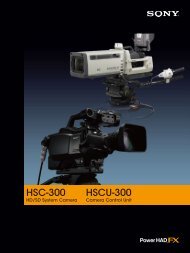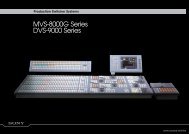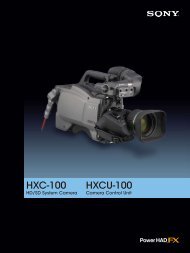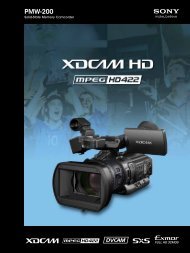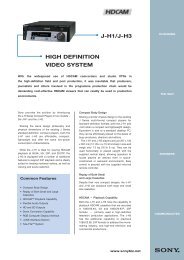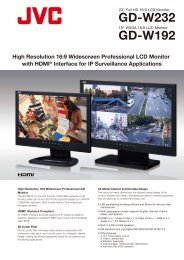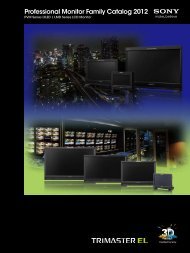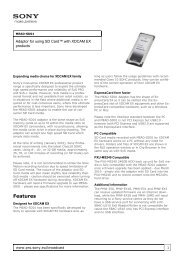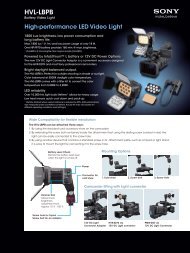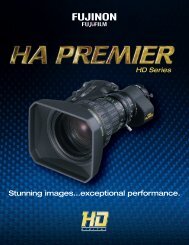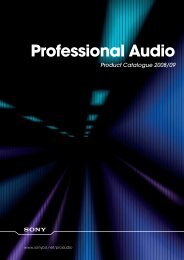Sony PDW-F75 / PDW-F335 / PDW-F355 brochure - Creative Video
Sony PDW-F75 / PDW-F335 / PDW-F355 brochure - Creative Video
Sony PDW-F75 / PDW-F335 / PDW-F355 brochure - Creative Video
You also want an ePaper? Increase the reach of your titles
YUMPU automatically turns print PDFs into web optimized ePapers that Google loves.
XDCAM HD<br />
IT/Network Friendly<br />
In the <strong>Sony</strong> XDCAM series of products, recordings are<br />
made as data files in the industry-standard MXF (Material<br />
eXchange Format) file format. This allows material to be<br />
handled with great flexibility in an IT-based environment -<br />
easily available for copying, transferring, sharing, and<br />
archiving. All these operations are accomplished without<br />
any “digitizing” process required. File-based data copying<br />
allows for degradation-free dubbing of AV content, which<br />
can be performed easily on a PC. The file-based<br />
recording system also allows for material to be viewed<br />
directly on a PC, simply by linking it to the XDCAM unit via<br />
an i.LINK or Hi-Speed USB (USB 2.0) connection*.<br />
This works in just the same way as a PC reading files on an<br />
external drive.<br />
The XDCAM HD camcorders and decks come equipped<br />
with IT-friendly, PC-based interfaces.<br />
These include an i.LINK interface supporting DV OUT and<br />
File Access Mode as standard, plus a Gigabit Ethernet<br />
interface available on the <strong>PDW</strong>-<strong>F75</strong> and <strong>PDW</strong>-F30 decks as<br />
an option. Connecting the XDCAM HD system to an<br />
Ethernet network offers users a new style of network-based<br />
operations that can dramatically improve the efficiency of<br />
their workflows.<br />
The <strong>PDW</strong>-U1** drive uses the common USB interface for<br />
easy connectivity and wide compatibility with most PCs.<br />
*Supported interfaces vary by products.<br />
**The initial version of the <strong>PDW</strong>-U1 is<br />
read-only, and cannot write files onto<br />
Professional Disc media. However,<br />
this capability will be available<br />
with a software upgrade<br />
targeted for release in<br />
spring 2008.<br />
No Overwriting to Footage<br />
– For Immediate Recording Start<br />
By virtue of recording on optical disc media, the XDCAM HD<br />
system makes each new recording on an empty area of<br />
the disc. This is extremely useful, especially when shooting<br />
with camcorders, as it relieves the concerns of camera<br />
operators about accidentally recording over good takes,<br />
and eliminates the burden of searching for the correct<br />
position to start the next recording. In short, it means the<br />
camera is always ready for the next shot.<br />
Instant-Access Thumbnail Search with<br />
“Expand” Function<br />
With all XDCAM HD products, video and audio signals are<br />
recorded as one clip file each time a recording is started<br />
and stopped. During playback, cue-up to the next or<br />
previous clips is possible simply by pressing the ‘Next’ or<br />
‘Previous’ button, as you would do on a CD or DVD player.<br />
Furthermore, thumbnails are automatically generated for<br />
each clip as a visual reference, allowing operators to cue-up<br />
to a desired scene simply by guiding the cursor to a<br />
thumbnail and pressing the ‘Play’ button. For further<br />
convenience, the ‘Expand’ function allows one selected clip<br />
in the Thumbnail display to be divided into 12 even-time<br />
intervals, each with their own thumbnail identifier. This is<br />
useful if you want to quickly search for a particular scene<br />
within a lengthy clip.<br />
Expand Function<br />
Scene Selection Function<br />
The Scene Selection function allows simple cuts-only editing*<br />
to be performed within the camcorder or deck itself.<br />
The results of the edits can be saved as an XDCAM EDL<br />
(called “Clip List”), which can be written back to the<br />
original disc to stay with the material.<br />
The disc can then be played back according to the Clip<br />
List so that only selected portions are played out in the<br />
desired order. The Scene Selection function presents<br />
dramatic improvements to conventional workflows, such<br />
as when transferring material to a nonlinear editor<br />
and/or server, or when searching for material and/or edit<br />
points in linear editing systems.<br />
When GUI-based operation is preferred, the Scene<br />
Selection operation can also be performed on a PC<br />
running the PDZ-1 Proxy Browsing Software supplied with<br />
all XDCAM products, providing a visually familiar working<br />
environment.<br />
*The video and audio of a clip cannot be edited independently.<br />
Selectable Modes of File Recording<br />
XDCAM HD camcorders and the <strong>PDW</strong>-<strong>F75</strong> deck provide<br />
two types of file recording modes. In standard operation,<br />
one clip file is created each time recording is started and<br />
stopped*. In the other mode, called Clip Continuous REC<br />
mode, which is a feature of the <strong>PDW</strong>-<strong>F335</strong>, <strong>PDW</strong>-<strong>F355</strong>, and<br />
<strong>PDW</strong>-<strong>F75</strong>**, one clip file can be created at the users<br />
discretion*. Although it is a single clip, Thumbnail Search<br />
operation and the Expand function are available just as<br />
if individual clips were created.<br />
Users can choose the most suitable mode depending on<br />
the type of application.<br />
*Each take needs to be longer than two seconds.<br />
**Available when recording is remotely controlled via an RS-442A or RS-232C<br />
interface, or during Trigger REC mode via an HD-SDI interface.<br />
Normal Mode<br />
REC START REC START REC START<br />
Clip 1<br />
Clip Continuous REC Mode<br />
Clip 2 Clip 3<br />
REC START REC START REC START<br />
Take 1 Take 2 Take 3<br />
Clip 1<br />
6



